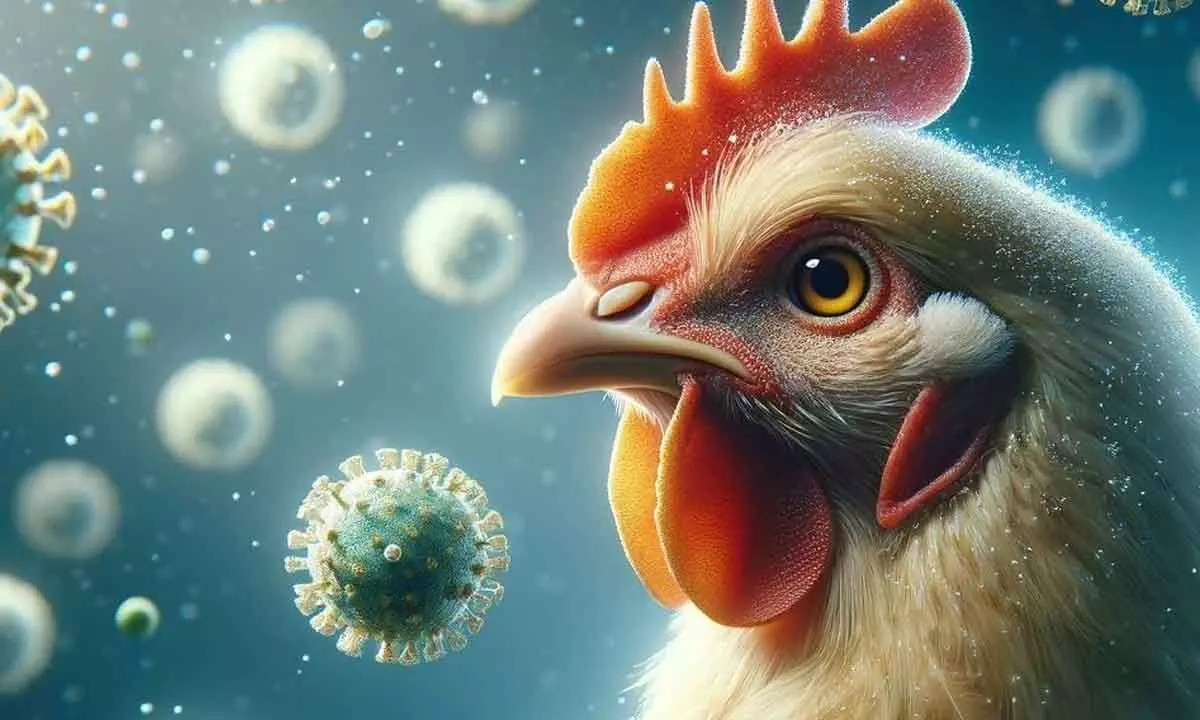Live
- Raghu Vamsi Aerospace to expand, will create 1,200 jobs soon: Minister
- 5th in a row: Nehru Zoo Park gets ISO 9001 certification
- Farmers throw marigold flowers on road due to drop in price
- Which one will you prefer caste census or skill census?
- NHRC takes cognizance of Lagacharla incident
- Telangana Cabinet expansion likely after Maha results
- Centre developed CFSL with int’l standards: Bandi Sanjay
- SVU embarks on promoting drone, space technologies
- HMWSSB MD inspects Mehdipatnam, Langar Houz
- Aging vehicles aggravate Hyderabad’s air pollution woes
Just In

The Influenza A/H5 virus is spreading through poultry and wild birds along well-defined migratory routes. Given India’s position along the migratory bird flyway, developing an effective strategy for migratory bird surveillance at water bodies during the winter season is emphasized for early warnings and disease control
The H5N1 highly pathogenic avian flu virus may be more infectious to humans if passed on from cattle than directly from birds, media reported, citing a team of researchers in Japan. The researchers led by Yoshihiro Kawaoka, director of the University of Tokyo, Pandemic Preparedness, Infection and Advanced Research Center, published their findings in the online edition of the British scientific journal Nature dated July 9, reported Xinhua news agency.
The team used receptors in human respiratory cells to react with both bovine-derived and avian-derived H5N1 viruses and found that the bovine-derived virus had stronger binding strength than the avian-derived virus, with the data suggesting that the former “more efficiently infects humans” than the latter, the media report published in Japanese daily Mainichi Shimbun said on Wednesday.
The H5N1 strain is characterised by its extremely high infectivity and virulence in birds. Global outbreaks began in the 2000s, causing mass deaths of chickens in many regions.
A series of cases of infection in various mammals have been found since 2020, with 28 human infections reported to the World Health Organisation, but no cases of human-to-human transmission have been confirmed, Mainichi Shimbun reported.
Four new human cases of highly pathogenic avian influenza, or bird flu, infection in the state of Colorado have been confirmed by the US Centers for Disease Control and Prevention (CDC), bringing the total cases to nine since 2022. The four presumptive-positive cases were reported by the state on Friday, and the CDC confirmed the infection on Sunday, according to a press release, Xinhua news agency reported. All new cases were in farm workers who were involved in the depopulation of poultry at a commercial egg facility experiencing an outbreak of highly pathogenic avian influenza H5N1 virus.
These workers reported symptoms after being exposed to infected poultry. The CDC said they reported “mild illness,” including conjunctivitis and eye tearing, as well as fever, chills, coughing, sore throat and runny nose. These are the first cases of bird flu infection in poultry workers since 2022 when the first-ever US case of H5 in a poultry worker was reported in Colorado, said the CDC.
A CDC team is on the ground in Colorado, supporting the assessment of the poultry outbreak and associated human cases, said the CDC, adding that “these cases again underscore the risk of exposure to infected animals.”
Bird flu outbreaks have affected poultry in 48 US states and 152 dairy herds in 12 states as of July 12, according to the CDC.
Amidst these developments, the Department of Animal Husbandry & Dairying of Indian government convened a high-level brainstorming session on Avian Influenza, focusing on surveillance and vaccination under the One Health approach. The session took place at Krishi Bhawan on Wednesday and was chaired by Secretary of the Department of Animal Husbandry & Dairying Alka Upadhyaya. The event was attended by a diverse group of officers and experts.
The poultry sector in India significantly contributes to nutritional security and supports livelihoods, particularly in rural areas. The sector, which has grown steadily at a rate of 7-10% over the past decade, also boosts trade and exports, contributing to the country’s economic growth. However, recurrent Highly Pathogenic Avian Influenza (HPAI) outbreaks hinder its potential and impact exports.
Highly pathogenic avian influenza (HPAI) H5 subtype virus is evolving biologically and expanding geographically, with the emergence of well-established genetic lineages. The recent HPAI outbreak in dairy cattle in the USA, with spill over to other mammals, underscores the pandemic potential of HPAI.
The session featured comprehensive presentations from the Human Health, Animal Husbandry, and Wildlife sectors, highlighting current surveillance protocols and response mechanisms for Avian Influenza outbreaks. The need for enhanced environmental surveillance and updating existing protocols was emphasized.
The Influenza A/H5 virus is spreading through poultry and wild birds along well-defined migratory routes. Given India’s position along the migratory bird flyway, developing an effective strategy for migratory bird surveillance at water bodies during the winter season is emphasized for early warnings and disease control. Special emphasis is placed on developing SOPs for environmental surveillance using low-cost methods at sites like wet markets, water bodies, wastewater, slaughterhouses, and poultry farms.
Vaccinated birds can still carry and transmit the virus without exhibiting symptoms, complicating surveillance and outbreak detection. This partial immunity can lead to the emergence of vaccine-resistant strains. Considering these scenarios and the difficulties in ensuring stringent biosecurity and movement restrictions, particularly in the backyard poultry sectors, experts advocate continuing the present strategy of surveillance and culling with no vaccination. However, the need for advanced research for vaccines for both humans and poultry birds is emphasized.
ICAR-NIHSAD, Bhopal, which has already commercialized the vaccine technology against Low-Pathogenic Avian Influenza (LPAI-H9N2), has taken a significant lead in developing an indigenous vaccine against HPAI. ICMR is also planning to initiate cell-culture-based vaccines against Avian flu for human use.

© 2024 Hyderabad Media House Limited/The Hans India. All rights reserved. Powered by hocalwire.com







